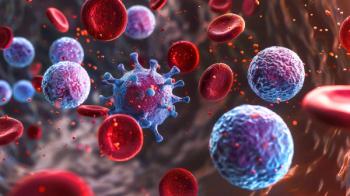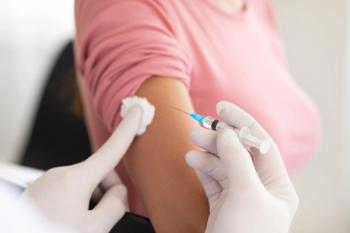
Pharmacy Practice in Focus: Oncology
- August 2020
- Volume 2
- Issue 4
CAR T-Cell Therapy in Refractory Large B-Cell Lymphoma and Acute Lymphoblastic Leukemia
CAR T-cell therapy involves collecting a patient’s blood, extracting the T cells within the blood, and returning the remaining blood back into the body, a process called leukapheresis.
The FDA designated chimeric antigen receptor (CAR) T-cell therapy a breakthrough therapy in August 2019.1 This recognition acknowledges that the therapy treats a life-threatening condition and has clinical findings demonstrating substantial improvement regarding clinically significant end points compared with other available therapies.
CAR T-cell therapy is different from other cancer treatments, as it uses the patient’s own white blood cells to eradicate cancer cells, allowing for treatment completion via a 1-time infusion. This novel therapy’s process involves collecting a patient’s blood in a certified facility, extracting the T cells within the blood, and returning the remaining blood back into the body, a process called leukapheresis. The T cells, the body’s primary killing cells, are then genetically altered to include the CAR. This allows the T cells to recognize cancer cells in a more advanced, precise way and eradicate them. The cells are then isolated in a lab, where they will continue to multiply until their numbers reach into the millions. The last step is the infusion of the T cells back into the patients’ bloodstream, where they will resume their growth to kill off the targeted cancer cells.2
CAR T-Cell Agents
Currently, only 2 CAR T-cell agents have received FDA approval: the autologous immunotherapies tisagenlecleucel (Kymriah) and axicabtagene ciloleucel (Yescarta), neither of which targets all cancer types. The indications of tisagenlecleucel, the CD19- directed therapy, are for patients up to age 25 years with B-cell precursor acute lymphoblastic leukemia that is refractory or in second or late relapse3 and adult patients with relapsed or refractory large B-cell lymphoma after 2 or more lines of systemic therapy; this comprises diffuse large B-cell lymphoma (DLBCL), high-grade B-cell lymphoma, and DLBCL arising from follicular lymphoma.3
The ELIANA trial (NCT02435849) evaluated the success rate of tisagenlecleucel, with its primary focus on quality of life in patients with refractory B-cell lymphoblastic leukemia, before and after receiving the therapy. At the conclusion of the trial, 81% of pediatric and young-adult patients who had refractory B-cell lymphoblastic leukemia treated with tisagenlecleucel had achieved and sustained remission within 3 months of infusion.4 Moreover, patients demonstrated quality-of-life improvements as early as 3 months after the infusion.
The second autologous therapy, axicabtagene ciloleucel, is indicated for the treatment of adult patients with relapsed or refractory large B-cell lymphoma after 2 or more lines of systemic therapy.5 In a clinical study of 101 patients with refractory non-Hodgkin lymphoma, 51% had a complete response and 21% had a partial response within 1 month of treatment.5
Therapy Limitations
The high success rates of these treatments may make some pharmacists wonder why they are used for refractory cancers only and not as often as other treatments. The first reason is the black box warnings associated with these drugs. Both agents can cause cytokine release syndrome (CRS), which includes life-threatening reactions.3,5 A CRS reaction is characterized by fever and hypovolemia and may even lead to end organ damage. Neurological toxicities are also part of the black box warnings and include possible encephalopathy, headache, delirium, and insomnia.3,5
Because of the possible serious toxicities associated with these drugs, they must be administered at certified facilities in the intensive care unit and are available only through a restricted Risk Evaluation and Mitigation Strategy program. Clinicians must also monitor patients for symptoms of toxicities for 7 days at the facility.
The second reason behind CAR T-cell therapy’s limited use is the price tag accompanying these drugs. For the treatment of B-cell lymphoma with axicabtagene ciloleucel, the price is set at $373,000 for the drug only, whereas the treatment of leukemia with tisagenlecleucel costs $475,000 for the drug only.6 Better results exhibited in leukemia account for the price difference for tisagenlecleucel in leukemia versus lymphoma.
Unlike other cancer therapies, such as chemotherapy and radiation, that kill healthy cells alongside cancerous ones, CAR T-cell immunotherapy targets the tumor cells with more precision. This therapy has been lifesaving for many patients.
Next-Generation CAR T-Cells
Tisagenlecleucel and axicabtagene ciloleucel are 2 drugs that show the future is bright for CAR T-cell therapy. Investigators have created a second-generation CAR T-cell therapy and have been testing this therapy for a couple of months now. In lab studies, the new therapy has demonstrated 100% long-term survival in relapsed lymphoma and leukemia.7
Investigators predict that human trials will begin sometime in the near future. In the next couple of years, the medical community may see the growth of CAR T-cell therapies with less of a concern for toxicities. Further, the targeted cancers may include solid tumors, as well, and the therapies may come with more reasonable price tags, offering patients increased access to these drugs when they need them most.
Sajida Nasser is a 2021 PharmD candidate at Nova Southeastern University College of Pharmacy in Fort Lauderdale, Florida.
REFERENCES
- FDA grants breakthrough therapy designation for new CAR T-cell therapy for B-cell acute lymphoblastic leukemia. National Cancer Institute Center for Cancer Research. September 10, 2019. Accessed July 15, 2020. https://ccr.cancer.gov/news/article/fda-grants-breakthrough-therapy-designation-for-new-car-t-cell-therapy-for-b-cell-acute-lymphoblastic-leukemia
- CAR T-cell therapy. Cleveland Clinic. Updated June 27, 2018. Accessed July 15, 2020. https://my.clevelandclinic.org/health/treatments/17726-car-t-cell-therapy/risks--benefits?view=print
- Kymriah. Prescribing information. Novartis; 2018. Accessed July 2020. https://www.novartis.us/sites/www.novartis.us/files/kymriah.pdf
- Laetsch TW, Myers GD, Baruchel A, et al. Patient-reported quality of life after tisagenlecleucel infusion in children and young adults with relapsed or refractory B-cell acute lymphoblastic leukemia: a global, single-arm, phase 2 trial. Lancet Oncol. 2019;20(12):1710-1718. doi:10.1016/S1470-2045(19)30493-0
- Yescarta. Prescribing information. Kite Pharma; 2020. Accessed July 15, 2020. https://www.fda.gov/media/108377/download
- Institute for Clinical and Economic Review. Chimeric Antigen Receptor T-Cell Therapy for B-Cell Cancers: Effectiveness and Value. ICER website. https://icer-review.org/wp-content/uploads/2017/07/ICER_CAR_T_Evidence_Report_021518.pdf Published February 15, 2018. Accessed July 22, 2020.
- Qin H, Dong Z, Wang X, et al. CAR T cells targeting BAFF-R can overcome CD19 antigen loss in B cell malignancies. Sci Transl Med. 2019;11(511):eaaw9414. doi:10.1126/scitranslmed.aaw9414
Articles in this issue
about 5 years ago
Managing Oral Oncolytics During the COVID-19 Pandemicabout 5 years ago
Brown Bag Consult®: Chemotherapy Recovery With Heart Problemsabout 5 years ago
Apixaban: A New Treatment Option for Cancer-Associated VTEabout 5 years ago
An Overview of CAR T-Cell Therapies and Adverse Effectsabout 5 years ago
What Does Excellence in Oncology Pharmacy Look Like?about 5 years ago
Stability of Rare TP53 Comutations in Patients With AMLNewsletter
Stay informed on drug updates, treatment guidelines, and pharmacy practice trends—subscribe to Pharmacy Times for weekly clinical insights.


















































































































































































































